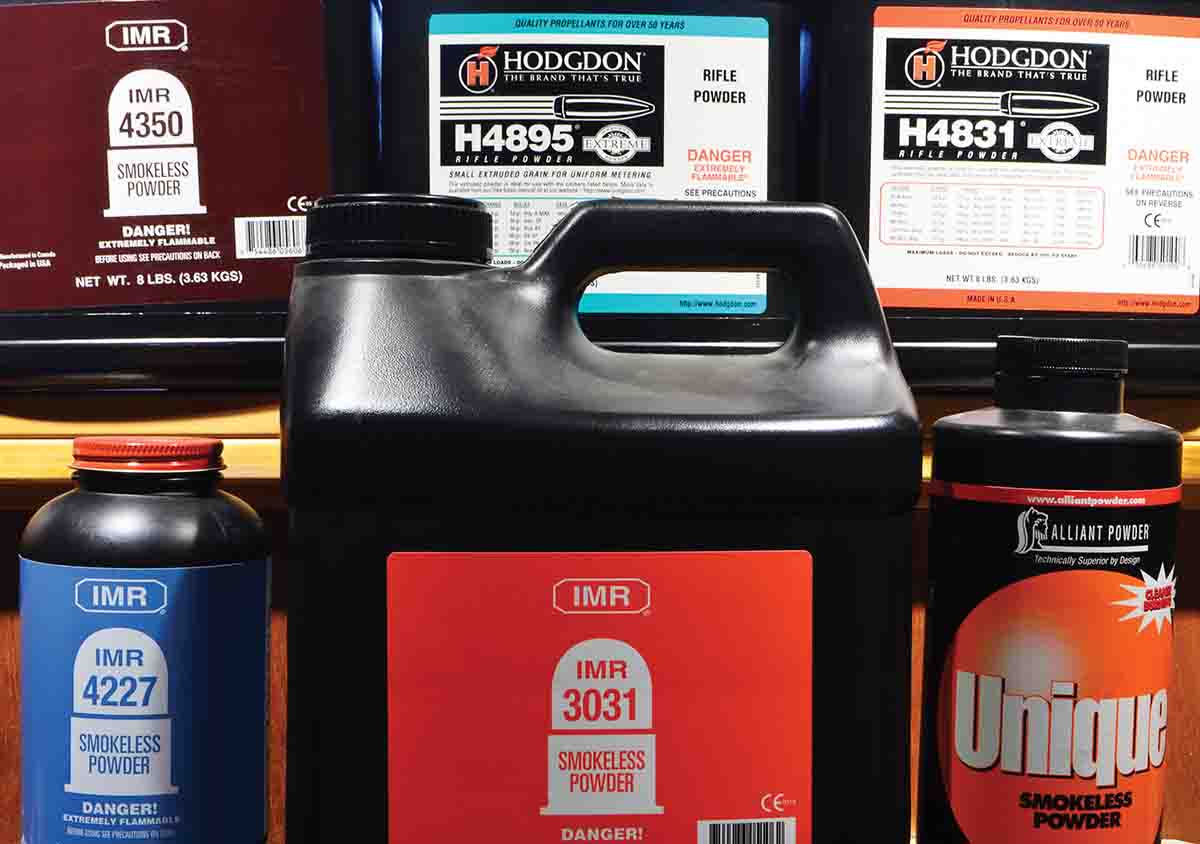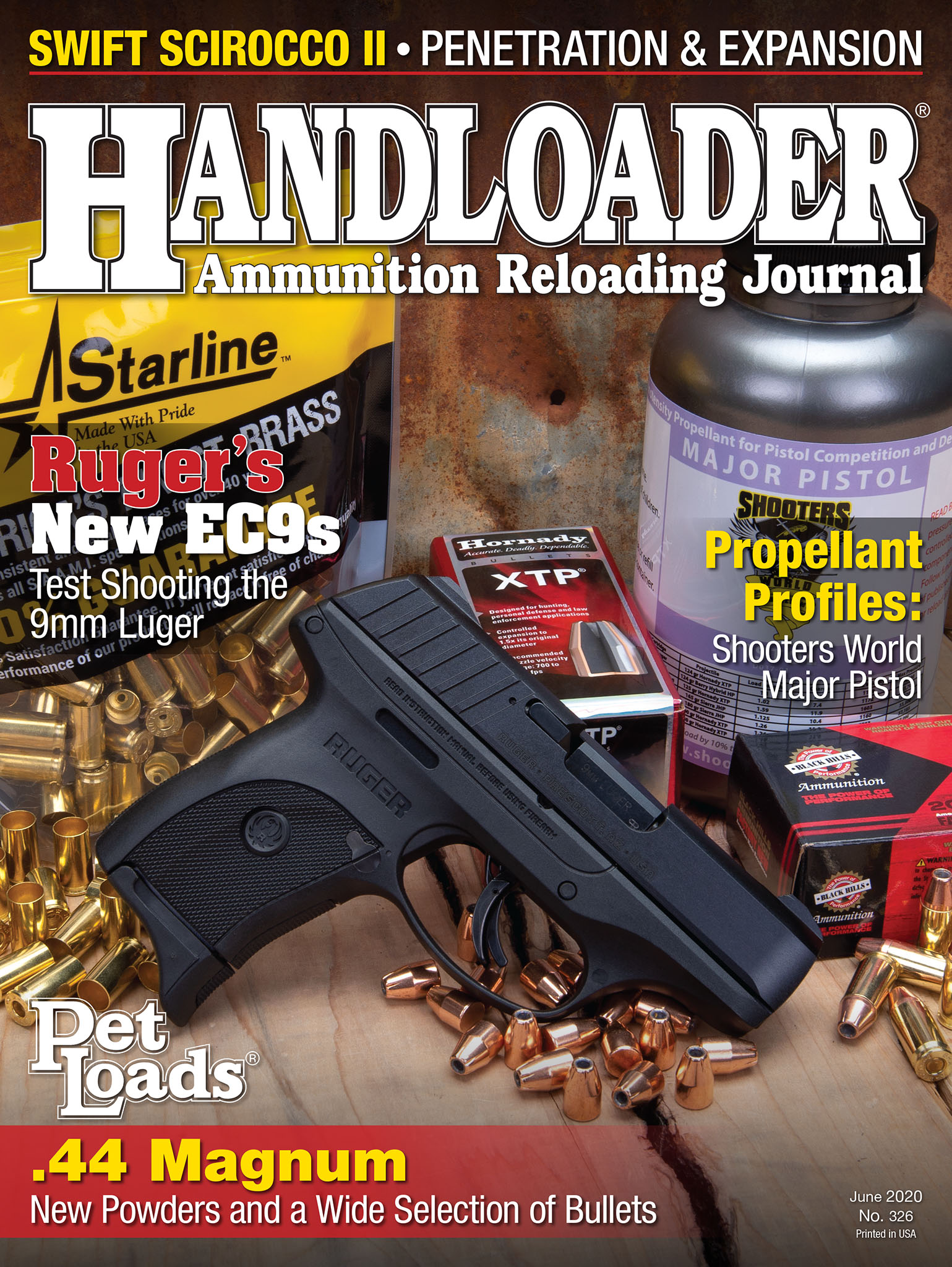In Range
Essential Powders
column By: Terry Wieland | June, 20

This thought occasionally crosses my mind, especially during those periods of political vagary when shortages occur – generally primers – or when a trusted old powder suddenly disappears from the shelves and there is a belated announcement that it’s discontinued. As someone who reloads older cartridges, working up loads from zero, the availability of particular powders becomes a serious concern.
By the time this column appears, we will be nearing the 2020 presidential election, and if there is any faint suggestion that an anti-gun candidate will end up in the White House, we could well be facing another of those cyclical shortages brought about by panic buying.
Having lived through three serious primer droughts and one stretch where .22 rimfire ammunition was all but unobtainable, I tend to keep substantial stockpiles. That includes powders, and especially those I either use on a regular basis or rely upon in emergencies. So back to the original question: You’re ordering a powder supply from scratch. What would you get?
Here is my short list of absolute essentials, and a second one of powders I would add if finances and available storage space permitted.
Alliant Unique
There is little you want to do with any handgun cartridge that Unique won’t do. It may not do it as well as some others, but bullets will exit the muzzle, usually with enough accuracy and almost always sufficient velocity. It’s our second oldest powder (second only to its stablemate, Bullseye), but it has stayed in the lineup since 1900 because it is just so useful. It can also be used for light loads in quite a few older, medium-capacity rifle cartridges, and you can usually dig up a shotshell formula as well. Since, in a period of shortages, a handloader might be casting bullets, Unique pairs well with lead in most anything.
H-4831
Hodgdon’s original slow-burning 4831 was the powder that made magnum rifle cartridges into powerhouses in the 1960s. It was slower than IMR-4350, the introduction of which in 1940 had encouraged the mushroom growth of the whole belted case short magnum line. H-4831, in both its original and short-cut versions, is a mainstay. Since the 1960s, any number of slower-burning powders have come along to support ever-larger cases with ever-heavier bullets, but if H-4831 won’t do it, I probably don’t need it done.
IMR-3031
IMR-3031 is covered at length in another article in this edition, but it has to be on the list. If H-4831 props up the magnum cartridge end, IMR-3031 supports the middle.
IMR-4350
The IMR version of 4350 is listed because it has seniority, but I would happily settle for H-4350, which in some of my rifles out-performs its predecessor. Preference for one or the other is mostly an idiosyncrasy of individual rifles. More of my rifles prefer the Hodgdon version, but there is more data, old and new, for IMR’s original. Send an 8-pound keg.
H-4895
This is another mid-size cartridge powder originally developed by DuPont for the U.S. military during the Second World War, and sold by Bruce Hodgdon as a surplus powder for many years thereafter. Aside from its undoubted virtues in this role, it has a unique application in that a formula exists for using it for very light practice loads. Anywhere formal, tested data exists, you can reduce it and have a comfortable, economical combination for practice. This alone makes it worth having around.
IMR-4227
This powder is indispensable for smaller cartridges such as the .25-20, .32-20 and the like. At one time, there were two 4227s – IMR and Hodgdon – but now there is only one. Which reminds me: I must order some more.
There are six powders listed which, if you had 8 pounds of each, would give you 48 pounds of powder. Most spouses, to say nothing of fire departments and insurance companies, think that’s already too much, whereas I think it’s the barest minimum. Let’s assume, though, that we have room for more.
Alliant Bullseye
Our oldest powder (introduced in 1898 by Laflin & Rand) is still immensely useful in cartridges like the .38 Special and 9mm Parabellum. For a century, it was “the” powder for .38 Special target rounds. It can be loaded to give higher velocity if needed, and it’s nothing if not economical. Years ago, a friend of mine had a 20-pound keg of Bullseye he bought in the 1960s and was still dipping into it in the ’90s. A few pounds goes a long, long way, and during any period of shortages, economy counts. It can also be used in shotshells.
Accurate 5744
This is a specialty powder, admittedly, being particularly useful for light loads in big cartridges like the .500 Nitro Express. There is a formula for determining suitable light loads based on case capacity, so you really don’t need published data. Heresy, perhaps, but there you have it. Accurate stopped publishing the formula some years ago for obscure legal reasons, but I’ve kept using it, and will continue to do so.
CLAYS
Hodgdon’s CLAYS is as close as we come to an all-around shotshell powder, and it can also be used in some handgun cartridges. For 12-gauge loads, I always use CLAYS unless I have a very good reason to use something else.
H-4198
Actually, either 4198 would be just fine, but I prefer Hodgdon’s – or at least, my rifles do. This is another older powder with an affinity for an extremely wide range of case capacities. This includes the .17 Remington on the small side to the .458 Winchester Magnum on the large.
Perhaps, like people who grew up during the Great Depression and never throw anything away, my character has been shaped by previous shortages. Whatever the reason, I like having a sufficiency not only of powder and primers, but of dependable data.
Loads published today by companies like Lyman and Hodgdon are based on much more technically-sophisticated equipment than that which appeared in old loading manuals, never mind books like Phil Sharpe’s Complete Guide to Handloading. However, if you are careful, you can usually reach a safe starting point by backing off published maximums even from such adventurous tomes.
All kinds of variables come into play, such as measurable differences in case capacity now, as compared to cases in use in the 1940s. Two spring to mind: the .270 Winchester and the .22 Hornet.
If you can find one, Homer Powley’s Computer for Handloaders, in the form of a cardboard slide rule, is extremely useful in devising starting loads where no data exists. The powders covered are limited to older DuPont numbers (4227, 4198, 3031, 4064, 4320, 4350) plus H-4831 and the long-gone 5010. (When the Powley was created, IMR-4831 did not exist, so it is identified only as “4831.”) You’ll notice that five of those are in my must-have lists above.
Newcomers to the Powley system should remember that its recommendation is not a starting load but the theoretical ideal load, which can be two very different things. Having run into one or two anomalies with it, I now back off from the recommendation by at least 10 percent to be on the safe side, and work up from there. But that is just handloading discretion applicable to most data sources.


